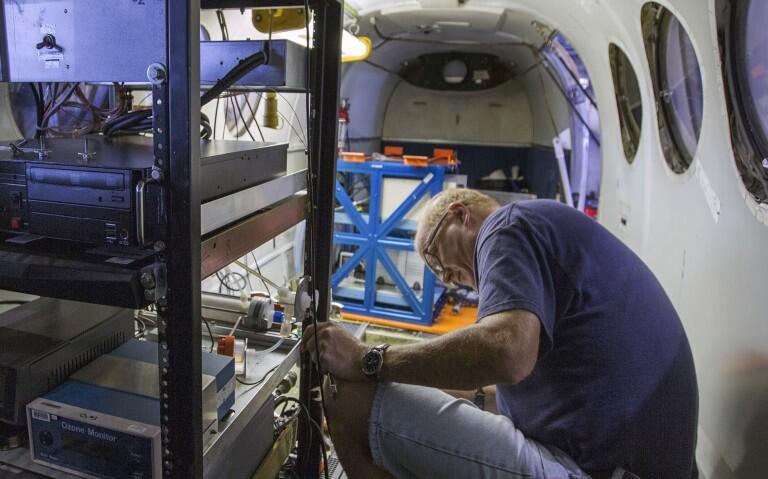This NASA airborne science experiment that started flights over the eastern United States this month resembles a classic case of “who done it?” ACT-America, the Atmospheric Carbon and Transport – America expedition, is studying the movement of two powerful greenhouse gases — carbon dioxide and methane.
It was hot and humid in the Mid-Atlantic region as the first set of science flights began in mid-July. The scene on July 18 was the hangar at NASA’s Langley Research Center in Hampton, Va. The lineup of potential suspects included gases from plants, fossil fuels, air conditioning units and electrical transformers.
Inlets built into several sensors on the belly of NASA’s B-200 aircraft take in samples of the air and atmospheric gas with the push of a button once the flight was underway. The sensors are strategically placed to not take in any exhaust from the aircraft.
For ACT-America’s first B-200 science flight, Colm Sweeney from the National Oceanic and Atmospheric Administration (NOAA) at Colorado State University watched from the hangar as the B-200 prepared for takeoff with NOAA’s flask package onboard. Air samples that fill the flasks are atmospheric fingerprints that provide clues about where individual chemical compounds came from.
“Plants take up lighter carbon, and emitted carbon has a different ratio,” Sweeney explained.
Gases have certain tracers, such as SF6 used in electrical transformers, and those tracers stay with them as they rise into the atmosphere as a plume.
“We’re basically getting a fingerprint on where the plumes are coming from,” Sweeney said.
Jim Plant was the lone instrument operator aboard the aircraft, accompanied by science instruments, a pilot and co-pilot to minimize the weight on board for a longer duration flight. The B-200 met up in a predetermined area or “box” along with the larger, more instrumented NASA C-130 aircraft that took off from NASA’s Wallops Flight Facility along the Virginia coast.
The B-200 made lawnmower patterns inside the box and circled down through layers of the Mid-Atlantic atmosphere to study how carbon dioxide and methane cycle into and out of the atmosphere.
“We want to better understand what’s going on inside the box to later extrapolate what’s going on outside of the box,” said Byron Meadows, ACT-America’s aircraft instrument manager.
With the push of a button onboard, a sample of air and gas fills the flask package, which is closed off from outside exposure. Once the dozen flasks are filled, the monitor reads, “Have a nice day.”
After the flights, the samples are sent back to a lab at Colorado State University where they are analyzed. The final step, according to Sweeney, is to model the samples to determine if carbon and methane emissions are increasing or decreasing.
“If we plan to curb emissions, we have to be able to check the accuracy of them and inform the proper policies needed to make a difference,” Sweeney said.
In addition to the flask system that collects samples from the air, several other instruments are integrated into the B-200 to study carbon and methane. Several ground measurement sites complement and fill in gaps between the study regions
This case is far from closed. In August ACT-America continues its sky sleuthing over two other parts of the eastern U.S. with flights from Lincoln, Nebraska, and Shreveport, Louisiana. With each passing flight, the data collected provides scientists with new clues that will help improve diagnoses of the global carbon cycle for decades to come.
Source: NASA











